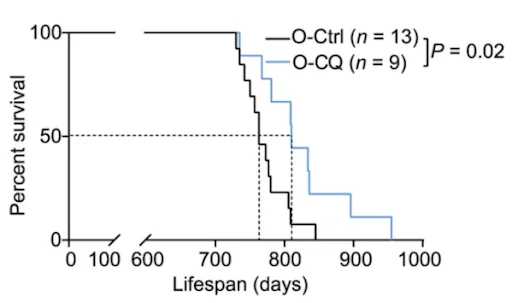Scientists have shown that chloroquine, a well-known anti-malarial drug and the cousin of hydroxychloroquine, attenuates inflammation and fibrosis while significantly extending median and maximum lifespan in naturally aged rats [1].
Fighting malaria since 1934
Chloroquine (CQ) was developed back in 1934 as an anti-malarial treatment and as such has enjoyed significant success. Since 2020, an analog of CQ – hydroxychloroquine – has attracted a lot of attention as a possible treatment for COVID-19, though its efficacy is heavily disputed [2], and the CDC currently does not recommend its use against the virus.
Over the years, more clinical uses for CQ have been found, including as an anti-inflammatory agent against rheumatoid arthritis. There were even some indications that CQ enhances the effects of chemotherapy and radiotherapy in cancer treatment [3]. More recently, CQ has been shown to reduce cellular senescence [4].
Can CQ extend lifespan?
Over the last few years, dozens of previously known compounds have been tested as life-prolonging interventions in animal models, and now CQ’s turn has arrived.
In this study, the scientists first conducted in vitro experiments to confirm the effect of CQ on cellular senescence. The researchers used human mesenchymal stem cells (hMSCs), multipotent cells present in many bodily tissues. The hMSCs were genetically engineered to recapitulate Werner’s syndrome, a type of progeria – in other words, they became a cellular model of accelerated aging.
Having treated the cells with various concentrations of CQ, the researchers found that in lower concentrations, CQ decreased markers of cellular senescence, but in higher doses, it actually increased them. This is consistent with CQ being known for rather severe side effects. Lower doses of CQ also increased markers of heterochromatin integrity, and heterochromatin destabilization is closely associated with aging and cellular senescence.
Next, the scientists treated naturally aged rats with CQ, sticking to a low and relatively safe dose of 0.1 mg/kg. 24-month-old male rats, approaching the end of their normal lifespan, were treated with CQ twice a week for five months. The treatment resulted in a 6% extension in median lifespan and a 13% extension in maximum lifespan, which is on par with some of the best anti-aging compounds ever tested in murine models.

Various markers showed a significant decrease in systemic inflammation. Notably, the levels of tumor necrosis factor alpha (TNF-α) and white blood cell count fell to the levels observed in young healthy rats. CQ treatment also attenuated fibrosis in the kidney, liver, heart, small intestine, and lung.
Interestingly, after showing anti-senescence potential in hMSCs, CQ failed to lower the levels of ß-galactosidase, a popular senescence marker, in any of the tissues that were analyzed. On the bright side, although liver and cardiovascular damage are among the most well-documented side effects of CQ, none were detected in the experiments.
Good for the kidneys, not so for the heart
The researchers also conducted a transcriptomic analysis to determine how the CQ treatment changed the expression of genes that are either upregulated or downregulated with age. In all but one tissue, most changes reversed rather than exacerbated the aging phenotype, with the notable exception of the heart, where pro-aging changes were more pronounced. This is consistent with the adverse effect that CQ is known to have on vascular function and warrants caution, despite the lack of visible damage to the heart. Of all the organs, the kidney was the one whose age-related genes benefited the most from CQ.
Among the affected genes, those associated with inflammation and fibrosis were downregulated in most tissues, while those involved in protein homeostasis, glucose metabolism, and fatty acid metabolism were upregulated. Although the treatment did not lead to a noticeable decline in cellular senescence, it downregulated some genes involved in the production of the senescence associated secretory phenotype (SASP), the signature mix of mostly harmful molecules secreted by senescent cells. Moving to higher doses probably would not have helped, since in the in vitro experiments, higher doses were shown to be less effective against senescence.
Conclusion
With this study, CQ joins the growing list of molecules that prolong lifespan in animal models. The idea of repurposing existing drugs, which are usually relatively safe, cheap, and widely available, as anti-aging treatments, is not new, and it holds a lot of potential. Time will tell whether CQ can hold its own against anti-aging stars such as rapamycin and metformin that are already in human trials.
Literature
[1] Li, W., Zou, Z., Cai, Y., Yang, K., Wang, S., Liu, Z., … & Zhang, W. (2022). Low-dose chloroquine treatment extends the lifespan of aged rats. Protein & Cell, 1-8.
[2] Chen, Y., Li, M. X., Lu, G. D., Shen, H. M., & Zhou, J. (2021). Hydroxychloroquine/chloroquine as therapeutics for COVID-19: truth under the mystery. International Journal of Biological Sciences, 17(6), 1538.
[3] Solomon, V. R., & Lee, H. (2009). Chloroquine and its analogs: a new promise of an old drug for effective and safe cancer therapies. European journal of pharmacology, 625(1-3), 220-233.
[4] Sargiacomo, C., Sotgia, F., & Lisanti, M. P. (2020). COVID-19 and chronological aging: senolytics and other anti-aging drugs for the treatment or prevention of corona virus infection?. Aging (Albany NY), 12(8), 6511.




